
September 1st, 2017 by admin
 Lead generation is, of course, important for any business with growth aspiration. Your video conference business may be using a number of techniques to attract and nurture leads including content marketing, email marketing, search marketing, social marketing, and more.
Lead generation is, of course, important for any business with growth aspiration. Your video conference business may be using a number of techniques to attract and nurture leads including content marketing, email marketing, search marketing, social marketing, and more.
One key challenge is to increase the lead to prospect ratio. In other words, you want to get more of the people that have at some point in the past shown an interest in your company in one way or another, to actually evaluate and potentially buy your products and services.
As a video conference business, you probably have multiple mechanisms in place to convert leads to prospects, including quote forms and trial of your virtual meeting room (VMR) service and endpoint registration and calling service.
The REC.VC White Label Edition for video conferencing resellers and service providers not only complements your existing portfolio of video conferencing products and services, it also adds to your existing lead to prospect conversion activities as it includes complete free trial functionality.
The white label edition includes the following:
- 1 white label site and domain (see yourbrand.rec.vc for details)
- Unlimited number of 14-day free trial accounts
- REC.VC Base Group 10 and Live Streaming 100 Subscriptions for your internal/demo use
- 100% hosted by REC.VC (customers select between US, EU or hosting in Norway)
The trial process work as follows:
- Person registers via your REC.VC white label site
- Person receives an activation link by email which automatically creates the trial account
- You’ll receive email notification for each sign-up and can follow their trial activities via the admin interface.
- Person’s trial account is automatically disabled after 14 days. The person will still be able to access his/her account to share and download recordings, but will not be able to start any new recording or streaming sessions.
To learn more about how your video conference business can leverage the REC.VC White Label Edition, please contact sales@rec.vc. You can also sign-up for your own trial account via my.rec.vc.
Posted in Channel, white label Tagged with: free trial, lead, prospect, recording, streaming, video conference

We believe organizations can increase the value its collective wisdom by recording and sharing meetings, workshops and training with the rest of the organization.
The REC.VC Enterprise Edition enables organizations to empower any employee to record & share, and optionally live stream, directly from their desktops, video conference endpoints or virtual meeting rooms. SIP, H.323, Skype for Business, and Chrome, are all supported.
The Enterprise Edition includes the following features:
SSO is based on REC.VC’ support for SAML 2.0 which enables integration with any SAML 2.0 supported authentication source.
Please feel free to contact sales@rec.vc with any questions.
New to REC.VC? Sign up for a 14 day free trial today!
Posted in Live Streaming, New features, Record meeting, Recording Tagged with: enterprise, recording, saml, sso, streaming
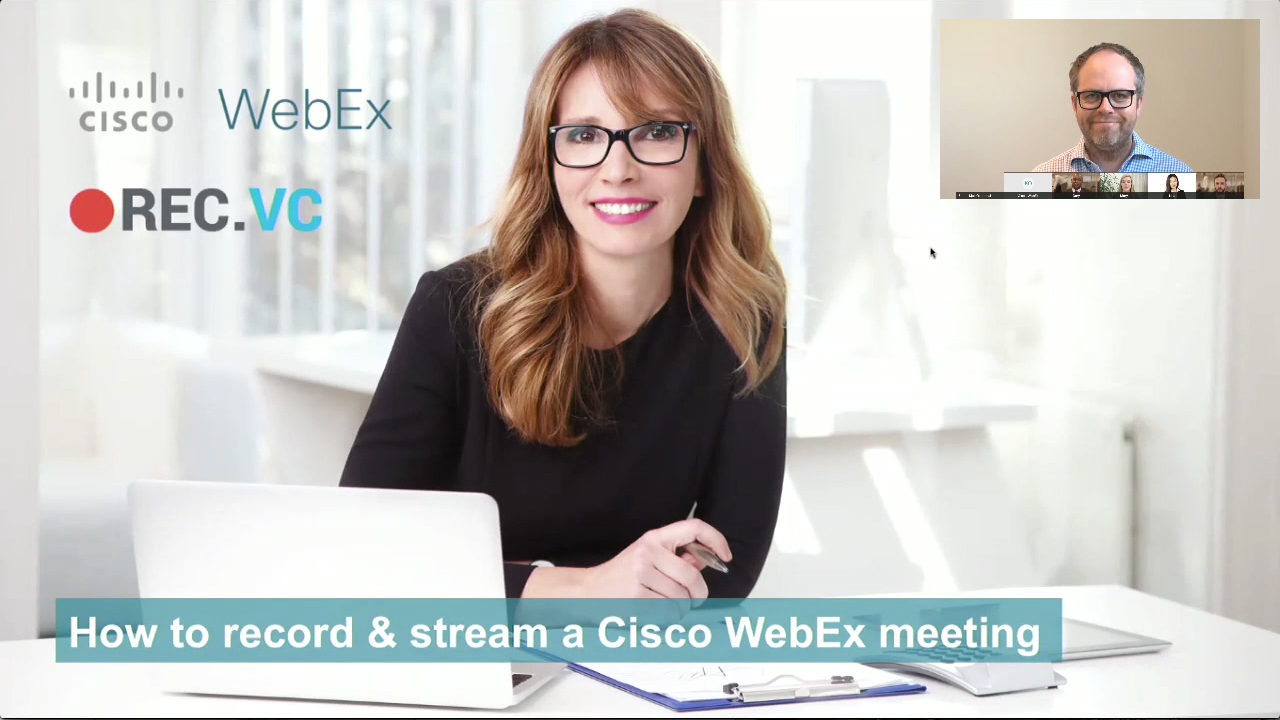
April 28th, 2017 by admin
We are often asked if REC.VC can be used to record and/or stream Cisco WebEx meetings. The short answer is yes, and the somewhat longer answer is that it is very easy to do. Here is how:
Start recording the WebEx meeting via the REC.VC interface
Enter the SIP URI of your Cisco WebEx room (typical URI structure is <alias>@<company>.webex.com) and the PIN code (if your room is PIN code protected), and click on the red record button.

REC.VC will then call to and join your Cisco WebEx room as a passive participant and start recording.
New to REC.VC? Sign up for a 14 day free trial today!
Start streaming & recording the WebEx meeting via the REC.VC interface
In the REC.VC interface, switch Mode to Stream & Record and select the appropriate Stream. Then enter the SIP URI of your Cisco WebEx room (typical URI structure is <alias>@<company>.webex.com) and the PIN code (if your room is PIN code protected), and click on the red Stream button.
 REC.VC will then call to and join your Cisco WebEx room as a passive participant and start streaming and recording.
REC.VC will then call to and join your Cisco WebEx room as a passive participant and start streaming and recording.
Stop recording (and streaming)
Top stop recording (and streaming), all you have to do is to disconnect the video call between REC.VC and Cisco WebEx, either by using the stop button in the REC.VC interface, or by disconnecting REC.VC via the Cisco WebEx participant list.
Cisco WebEx Recording & Streaming Layout when using REC.VC
When content is not shared, REC.VC will record (and stream) using Cisco WebEx’ regular participant layout:
 When content is shared, the recorded (and streamed) layout will be based on how your REC.VC account is configured (by your REC.VC admin or by support@rec.vc). Two options are available:
When content is shared, the recorded (and streamed) layout will be based on how your REC.VC account is configured (by your REC.VC admin or by support@rec.vc). Two options are available:
Layout option 1: Standard Cisco WebEx layout
REC.VC will in this case receive one mixed stream from your Cisco WebEx room:
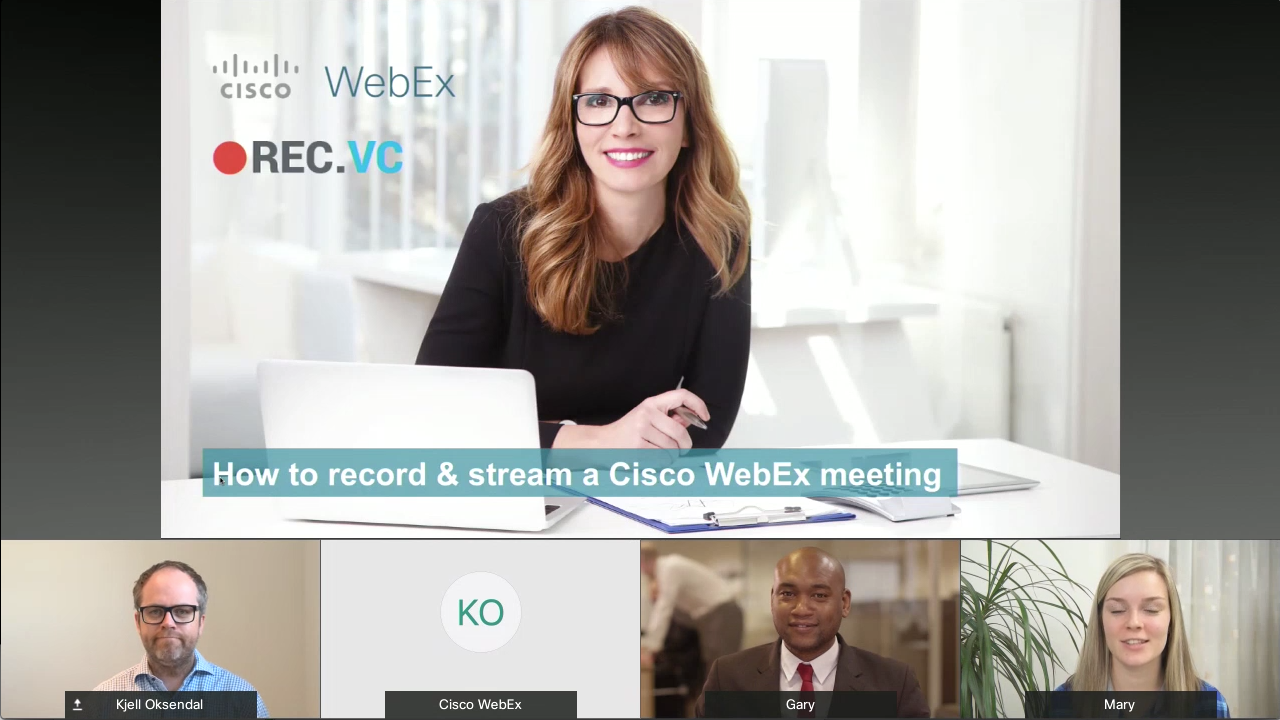 Layout option 2: REC.VC mixed layout
Layout option 2: REC.VC mixed layout
REC.VC will in this case receive two streams from your Cisco WebEx room (based on BFCP) and mix the two streams as follow:
- Content 100% of screen
- People in top right hand corner (PIP)

New to REC.VC? Sign up for a 14 day free trial today!
Posted in Live Streaming, Recording, Third party Tagged with: BFCP, cisco webex, layout, recording, streaming

March 23rd, 2017 by admin
We are thrilled to share with you that we will establish a REC.VC Site in Toronto to serve Canadian enterprises and organizations with the number one cloud service for recording & streaming of video meetings.
The REC.VC Site in Toronto will be fully operational by June 2017.
REC.VC Sites are today available in Ashburn (USA), Frankfurt (Germany) and Oslo (Norway), enabling customers to select the location that best fits their regulatory and compliance requirements. Customers also have the option to leverage multiple REC.VC Sites, which can be ideal for global organizations.
New to REC.VC? Sign up for a 14 day free trial today!
Posted in Uncategorized Tagged with: canada, recording, streaming, toronto, video conference
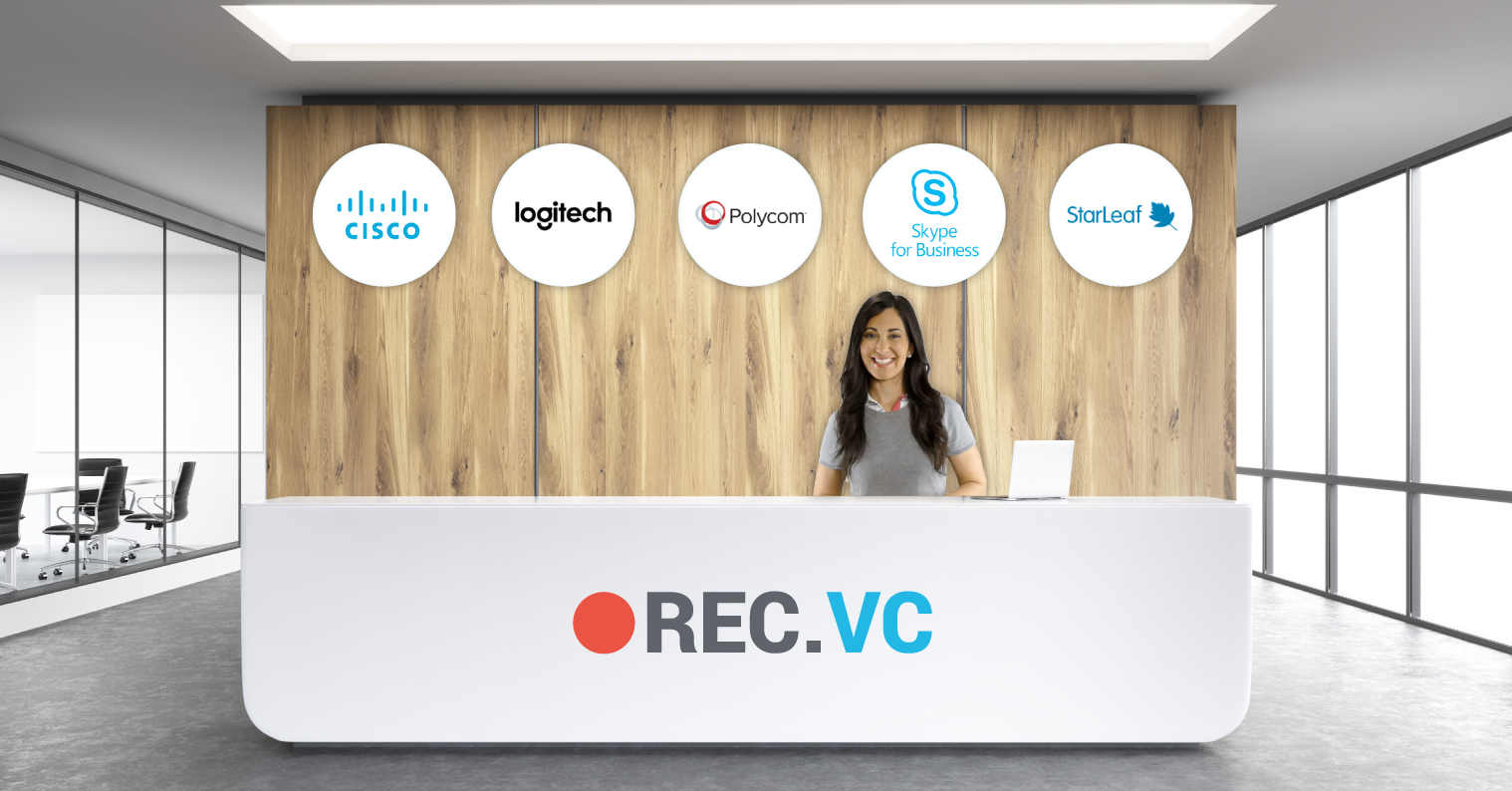
March 16th, 2017 by admin
Increase the value of your collaboration
If you’ve deployed a video collaboration (VC) platform within your company or are considering doing so you know that it is a major investment. There is of course the monetary aspect of the investment but other items that need to be considered include the time required by support staff to plan and deploy the solution, training your users, and the ongoing support and maintenance of the platform. All in all you are looking at a lot of time, effort, and money spent in launching a collaboration service for your company, so wouldn’t you want to get as much out of it as possible?
One aspect of VC that can sometimes be overlooked is the ability to record and stream over video. No matter what kind of video deployment you have, from fully loaded conference rooms with dedicated hardware endpoints to end users equipped with cost efficient webcams; all of these items are already recording and streaming ready.
You have enabled your organization with VC because you believe in the value that collaborative sessions create for your organization. By recording (and optionally streaming) the same sessions, you further increase the value of your collaborative teams by making the collective wisdom available to the rest of your organization.
Videoconference recording & streaming is available in the cloud, making it very easy and cost effective to implement and consume across your organization.
Use Cases
The benefits of adding this additional functionality are vast, especially when you factor in the ease of deployment and simplicity of use that a cloud solution brings. One of the oldest and most widely known uses for VC recording is capturing a meeting so it can be reviewed later or for its content to be documented and readily available. We believe that this use case will continue to be in high-demand, and probably even grow, with availability of VC equipment in meeting rooms and the ease of use of cloud services. With the evolution of the connected workplace and remote teams, we see a number of new recording and streaming use cases. Some of these include:
Recording a personal update from any device:
- Spontaneous video congratulating your team or company on a job well done.
- Update your dispersed team on a project item or milestone.
- Personal thank you to a colleague for their assistance.
- Mental notes for your self or to share with team members
Recording for recruitment processes:
- Ask candidates to record a short personal introduction to go along their job application and resume
- Record the interviews and share with relevant stakeholders internally, or simply go back to the recording when reviewing and comparing the candidates after each interview round.
Other use cases:
- Remote recordings or streams via a mobile device in the field.
- Recording fun skits, songs, or jokes for your next company party or simply just to make things more fun.
These items mostly touch on recording, while streaming has a multitude of use cases on its own. Company all hands meetings are a clear focus here. With businesses wanting to provide their employees updates on company performance and changes the best method is streaming. Gone are the days of trying to get the entire company onto a call, trying to overcome numerous connection and audio issues, and the expense of such an event. Streaming is the clear winner here for ease of use (for the broadcaster and the viewer), cost, and support required for broadcasting an event. Other use cases for streaming include investor calls, webcasts/webinar replacements, live instructional training, internal executive announcements, and more.
Equipment
The above use cases are important because in years past they required so many elements to make a reality. Let’s make a short list for what it used to take for a quality recording to happen:
- High quality video camera
- Proper mic system to capture good audio
- A technician to help setup and run this gear and help with recording
Taking a look at this list, if you have a VC deployment, all your rooms with a video unit and all your users have already have these items. For rooms with video hardware, your nice camera is covered along with your mics. VC hardware has advanced in leaps and bounds over the last few years and even if your video unit is a few years old, it is likely you have a high quality camera with a good mic system connected to it. With a cloud recording solution everything is already in place in terms of gear, all that’s needed now is to dial an address and you are recording, and it doesn’t require a videographer or IT personnel to do so.
Taking it a step further, any video enabled user has the same capability. Computer based webcams are inexpensive while providing high quality video and decent audio along with wired or bluetooth mics that can enhance audio even more. It is likely that most users already have both of these items, making them not only able to record or broadcast, but do the same from almost anywhere since this equipment can be mobile.
Streaming Solved
The above primarily discusses recording, but the same benefits are also true to streaming equipment. In the past, to stream live video it would require servers dispersed across your organization to transcode and serve media to viewers. The bigger the organization, the more hardware required for a good experience. There were network implications that needed to be considered to have hundreds or thousands of viewers of a broadcast as well as additional considerations for anyone who might want to watch from outside of the internal company network. The cost to run and maintain such a deployment could be a daunting task requiring the time of many IT professionals.
With cloud streaming all of these worries are out the window. A VC deployment in place with a cloud streaming solution alongside, beginning a stream is a simple as dialing an address and sending out a link. IT doesn’t need to worry about anything but making sure you can call from your VC room or software client. No more servers to maintain, bandwidth or QoS considerations to worry about, or concerns about media reaching remote locations. This is all taken care of by the provider. Again, all the equipment you need to worry about is most likely what is already in place and well supported.
Now What?
If your business has a VC deployment or is planning to launch one, you already have most of the hard parts of a recording and streaming solution in place. The final piece is a very affordable and easy-to-use cloud service that can be enabled and deployed in a very short time. This can breathe new life into gear that might not be getting much usage or bring added benefits to an already well used deployment. The only next steps you might want to think about are giving proper info on how to use the service. Since dialing an address is simple not a whole lot has to be done there but giving insight on how users can manage and send out their recordings is definitely important. Lastly it is always a great idea to provide some general tips when it comes to recording and streaming.
- Lighting and decent background – If you’re in a conference room, odds are your lighting is already good. However it is a good idea to make sure people know that there shouldn’t be a bright source of light behind them. This will wash out the video. Having a nice background really helps make a video recording or broadcast shine.
- Try to avoid reading from a script – If you’re recording a video message to send out, reading from a script is usually a no-no. It can make speech seem robotic and disconnected. If anything have major points listed on a sticky note for inspiration. Try to speak naturally like you were actually talking with someone in front of you.
- Look into the camera – This one is often overlooked. It is very hard to do but if you look into the camera when recording or streaming it makes it seem as you are looking directly at your audience. A small detail that will make a bigger impact in your recordings.
- Show things! – This is something that can make things a little more fun. Since you are on video you have the ability to make things interesting by showing things to your audience. This could be a souvenir that you got on a vacation or simply something you enjoy that might spark a connection to bring your audience closer. Through video you can make things more interesting in a number of ways so think about how you can make your calls, recordings, and broadcasts more interesting.
Happy recording and streaming to you!
Posted in How to, Live Streaming, Record meeting, Recording Tagged with: collaboration, recording, recruitment interview recording, streaming

January 19th, 2017 by admin
While many organizations, small and large, have begun to move as many services as possible to the cloud, so begins the move of their collaboration platform of choice.  While moving services such as documents and data began first and are an easier migration, moving video services to the cloud has been a bit slower.   However the last few years have seen an emergence of many top tier cloud video collaboration providers, making a transition from on-premise equipment and services more worthwhile.   As this shift gains more momentum there is one key collaboration component that is poised to make it’s leap to the cloud along with the rest; recording and streaming services.
There are many players in the recording and streaming space when it comes to video conferencing in enterprise. Â Likely the most notable is Cisco, with their Telepresence Content Server which came in the acquisition of Tandberg in 2009 and allowed users to dial an address to begin recording (and eventually streaming) video calls . Â Cisco has not made any major updates to TCS in years and has announced end-of-life.. Â
Additional players in the space include but are not limited to Polycom, with the RealPresence Media Suite as well as Lifesize, Qumu and Vbrick. Â However many providers do not offer cloud solutions at this time or are very early in their deployments, providing only limited cloud capability without requiring the customer to add on-premise equipment.
Why put Recording and Streaming in the Cloud?
The benefits of moving to the cloud have been increasingly clear. Â Flexibility, ease of scale, mobility, and less overhead are a few key factors out of many for migrating just about any business component away from on-premise. Â In terms of recording and streaming specifically storage is a major factor. Â As cameras and video technology improves, video files sizes are growing. Â Socially we have become more media centric and are creating more content than ever. Â Combine these two factors and storage capacity can disappear at an alarming rate . Â Why worry about continuously expanding the hardware storage in your data center when your cloud provider can do this for you? Â This is a big savings on gear and time spent on ordering, installing and maintaining it all. Â The ability to receive new features and services without having to worry about upgrades is a big plus as well.
In addition, playback and viewing of live streams of video meetings has naturally become more cloud-centric. Â In years past, most employees worked within the office and joined all-hands meetings in person or in connected conference rooms. Â These days the work force is dispersed and we all expect to be able to view recordings and streams on mobile. Â In the past this kind of viewing would have required a VPN connection back to the office among many other technical barriers. Â Today it makes sense that this function live in the cloud as it provides better ease of access for an increasingly mobile population. Â Â Let your provider handle storage, distribution, accessibility, and more so your IT staff can focus on more important things than maintaining a complicated network of on-premise servers connected to content delivery networks.
|
Feature
|
On-Premise
|
Cloud
|
| Encryption of recording and streaming sessions |
✓
|
✓
|
| Record from any device or platform |
Depends
|
✓
|
| Record out of the office while on the go |
Depends
|
✓
|
| Simple user creation and account management |
Depends
|
✓
|
| Easy scalability |
|
✓
|
| Automatic, worry-free backup |
|
✓
|
| Easy, secure, distributed delivery without additional assistance and cost from  a CDN |
|
✓
|
| Automatic updates and rollouts of new features |
|
✓
|
| Total cost of ownership |
High (opex and capex)
|
Low (opex only
|
Â
Recording and Streaming Cost of Ownership
This is a major factor when considering a move of recording and streaming services to the cloud.  Let’s do a quick breakdown. Â
Hardware Costs
Mentioned above, if your recording and streaming services are on premise, you’ll likely need multiple physical servers, especially for proper distribution across remote offices.  The bigger the and more distributed the deployment, the more servers you need.  This takes up rack space in your DC, requires power and cooling, but more impactfully, requires disaster recovery in place for backups and the possibility of server failure. Â
Staff Costs
Servers don’t run themselves.  You’ll need an IT person (or people) to manage all the above hardware as well as run upgrades and maintenance in an on-prem scenario.  You’ll need to watch out for things like capacity and storage and plan routine hardware refreshes to keep up. Normally these tasks fall on your network team or similar group, and don’t you pay these teams to do more important things like keep your network up and running?  Â
The Streaming Element
Streaming is becoming less of a nice to have and more of a requirement these days. Â On-premise streaming deployments are often complex and take up a lot of time of your network team and other IT staff. Â Managing the servers and network support to ensure a successful livestream is a huge time suck. Â You can leverage a CDN for this but this is also time spent and more cost on top of your on-premise costs .
It is clear that there is big savings in moving recording and streaming services to the cloud. These savings can be seen not just in your budget but in freeing valuable time of your staff to focus on more important tasks. Â
Recording and Streaming: Integrated vs Standalone?
Some collaboration cloud services have native recording & streaming functionality while others don’t.  If these services are important to you it makes sense to use a standalone recording and streaming service like REC.VC. This allows you to record from any device or platform.  With today’s volatile and ever improving collaboration market, it might take a few tries to find a service that properly fits the way your business operates.  Imagine having to switch or update your collaboration and having to learn and acclimate to a new recording platform along with everything else?  With REC.VC you can continue to record and live stream regardless of the collaboration platform or devices you’re using.  Agility at it’s best.
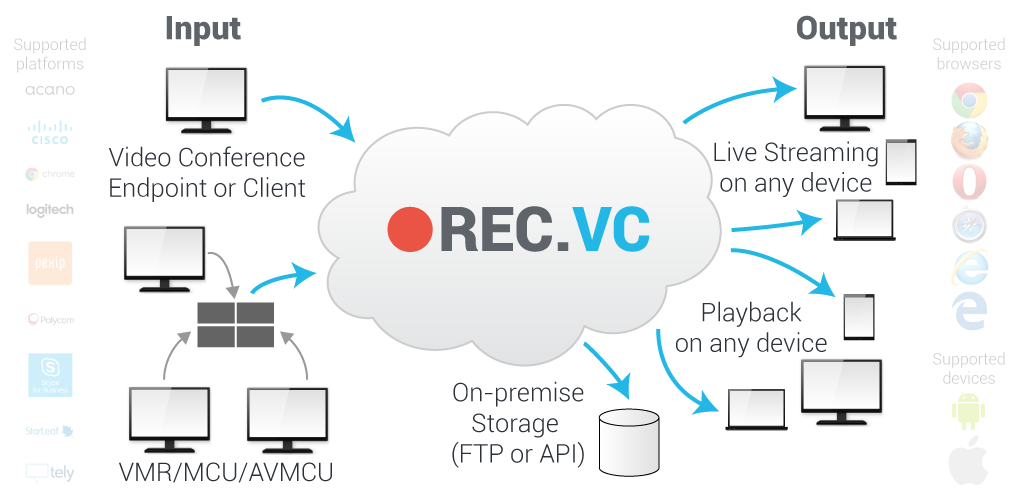
Recorded Content Control: One Platform vs. Many
With the increasing amount of collaboration tools emerging, businesses will often find employees using a multitude of non-company-standard apps and services, sometimes with overlapping features. Â Â Recording often falls into this category. Â This can be a huge complication. Â Competing services regularly have vastly different practices when it comes to recording. Â Some have different file formats, many require users to save recordings on their laptops while some could be stored on an unsecured server somewhere. Â This can become a real mess when you have company recordings spread all over the place and users with company issued computers running out of space on their hard drives or needing video files converted to other formats, Â subsequently calling IT for assistance. Â Â A cloud solution ensures all your recordings are secured in one place, no matter what device is used to create the content, all easily retrieved and accessible from any device while removing many troublesome IT obstacles.
In conclusion, it is somewhat of a surprise that most recording and streaming services were not cloud ready, and adopted sooner.  The benefits are many: increased mobility and ease of use for users, device and platform agnostic usage, easier deployment and management, lower overhead and associated costs in hardware and IT support, content control, and lots of flexibility.  The good news is that a robust, feature-rich, simple recording and streaming solution  is ready for you in the cloud with REC.VC.  Make your move today.
Posted in Live Streaming, Recording Tagged with: content server, media suite, recording, streaming
January 11th, 2017 by admin
Written by and published with permission from Matt Stevenson @Â Connected Frequencies.
Happy New Year to all! Another year gone by with technology of all kinds advancing in leaps and bounds. The collaboration and unified communications industry saw no exception to this growth. To name a few things, in 2016 we saw things like Acano being acquired by Cisco for integration with the Spark platform, Microsoft continuing its expansion into the UC space with big growth in Skype for Business, and Slack taking the world by storm, making us all rethink email and text communication. 2017 will be no different with some new platforms coming of age and a continued shift in the way technologies are deployed. Let’s take a look.
LESS EXPENSIVE VIDEO HARDWARE IMPROVES AND GROWS
It has been a headline for a few years now: the hardware video endpoint is dying. While it will be some time before the dedicated endpoint is truly dead due to the needs of larger enterprises with conference rooms and meeting space that only a hardware endpoint can fill, the new “endpoints†are your computer and your mobile device. In times where everyone has an endpoint and networks are more robust than ever, even larger businesses are looking to reduce spending on expensive, room based hardware.

Companies like Logitech have been doing well making webcams for personal use and more recently, devices for the conference room in their “ConferenceCam†line. Look for them to continue to push this tech, but in 2017 look to new entrants in this space. One newcomer is Huddly, promising high quality video meetings for small to medium sized groups with a wide angle camera that is small and portable. Another is a product from Owllabs which is more like a smart camera that creates an immersive experience via intelligent participant tracking and software that smoothly transitions from one speaker to the other, all in a small, low cost package. With more and more video calls taking place via software these days, I see these affordable devices with improved features having big growth this year.
VIDEO STARTS TO GO INBOUND
Video collaboration has traditionally been a planned, outbound experience. Here participants know they need to do a call, schedule it in advance, and one party calls another at the desired time. As things have advanced participants meet in a virtual meeting room, where the experience is more flexible, but still usually a planned experience. As more open technologies emerge and technologies like WebRTC improve, this is opening up a world of possibilities for a more inbound experience.

We first saw this in a big way a few years ago when Amazon launched its Mayday service, an inbound mechanism designed as product support for customers using Amazon tablets. Amazon tablets didn’t really take off but the idea was great. Fast forward a few years and today’s web is ready for inbound video. With API’s from companies like Pexip and Tokbox allowing you to create your own video experience in a browser, there are endless possibilities here. HR, marketing, sales, and support teams could do quite well with a way for customers to contact them (inbound) over video, and each day there are more companies looking to embed video calling into their web products. There are solutions out there today, but this is essentially an untapped market. I see lots happening here in 2017.
WEBRTC: GETTING BETTER (ON THE DESKTOP), BUT STILL NOT QUITE “THEREâ€
The last few years were supposed to be “the year or WebRTCâ€, the video standard that allows for video calls within a web browser, yet the technology still isn’t quite there. It is absolutely amazing when it works, but there are many places that can cause failures. Participants not being able to see or hear is still rampant due to device problems and user error. But the main issue is that not all web browsers fully support WebRTC, those that don’t require plugins, and we unfortunately still have a lot of people using Internet Explorer (!) which has never really provided a good experience for video in this way. Things are changing here with IE fading more quickly with Microsoft launching their new Edge browser last year. Also in 2016 Apple announced support for WebRTC in their browser Safari.

While WebRTC on Safari on the desktop isn’t the biggest deal on the desktop with Apple having only a small share of that market, what is a big deal is WebRTC support on Apple’s mobile devices iPhone and iPad in which they do have a big market share. While this all sounds great, it is unlikely that in 2017 we will see this change. Apple has always been strict when it comes to battery life, and WebRTC has been known to be a battery and bandwidth hog depending on how it has been implemented. Combine this with the fact that most Android devices don’t have the hardware or software required for a good WebRTC experience and you can expect that WebRTC will continue to grow on desktop this year, but overall, not as much as it could if it truly shined on mobile.
RECORDING/STREAMING BECOMES A BIGGER PART OF THE UC PICTURE
Recording and streaming, a feature once only available to large enterprises with the money and deployment to support something like the Cisco Content Server, is now more accessible to all. As nearly everything in the tech space moves to the cloud, so does recording and streaming. As we know, cloud services are much easier to deploy and maintain and allow more ROI for customers than on-prem equipment. As equipment costs continue to drop, storage and bandwidth costs go down, allowing large video files which were once a burden to IT to float in the cloud, accessible at any time. More importantly, now any user can have access to recording and streaming which was once limited to a select few due to technical and logistic restraints.

With these improvements, the uses of these tools can be more realized. Once only for the simple task of recording a video meeting for future playback, calls can now be recorded as well as streamed to large audiences on any device including mobile, allowing anyone in a business to join a large all hands call without the cost of having everyone actually join the call. Other uses that will grow are recording short messages for a team or team member, almost like a pseudo video voicemail we’ve all talked about for a while. Better still, any user whether it’s someone HR creating an internal announcement, someone from marketing creating a customer facing video, or someone from IT recording a training, anyone can create a video in seconds using the equipment they have right in front of them, stored securely in the cloud for easy access and sharing. Look to REC.VC from MNS leading the pack here with a cloud platform that offers superb quality, security, and features in a dead simple user interface.
MICROSOFT AND PEXIP, SITTING IN A TREE…
Microsoft continues to gain ground in the UC space with the way they offer and market Skype for Business (basically free with other Office/O365 products). It is hard for an IT manager to say no to this price when other solutions technically cost much more and don’t offer tight integrations to Microsoft’s Office Suite. With this unified experience and the visual refresh taken from Skype finally completed last year in updates to the mobile apps and Mac app, more orgs are turning to Skype for Business for their needs. While it is a good solution to a point, the biggest issue has been interop in that S4B users often can’t call people on different devices and protocols. The solution works great if you’re only talking to others with Skype for Business but that simply isn’t the world we live in. In today’s connected world you need to be able to call more than just those using the same software as you do.

Enter Pexip, likely the current leader video conferencing interoperability, especially when it comes to Skype for Business. This is on top of an already robust, cutting edge platform that is advancing more rapidly than most on the market. Their Skype for Business gateway functionality allows S4B users to easily call other devices with all the interop magic happening in the background. Pexip is the perfect solution for what S4B is lacking. It is a wonder why Microsoft has not made a deeper partnership or outright purchase of Pexip. Even a business outside of Microsoft would do well in acquiring Pexip just to make use of the S4B interop. Either way, expect more purchases in this market throughout 2017. As buyers require their apps to be more unified, we’ll see more acquisitions where “older†businesses trying to keep up with competition make purchases of video centric solutions in attempts to patch together unified solutions based on one or more products they already offer. I agree with Rowan Trollope of Cisco here.
SLACK-LIKE SOLUTIONS AND THEIR EFFECT ON VIDEO COLLABORATION
2016 was the year of Slack with its frictionless approach to chat, sharing files, and more recently, voice and video calling. Thousands of teams and companies hopped onto the platform as many pundits declared email to be dying in the wake of Slack’s growth. While that might be somewhat far from true, what can’t be denied is that Slack and apps like it are here to stay. Cisco is trying to emulate in Spark as is Microsoft with their Teams service. Even Facebook getting into the game with “Workplacesâ€. So how does this affect video collaboration?

It all goes back to that magical word: unified. In the past multiple separate apps were used to do different things; one for chat, one for screensharing, and so on. Today the demand is to have all communication needs served in one tool. This will drive acquisitions as mentioned above as providers attempt to offer the best complete solution being that most “UC†solutions started with chat or voice and are looking to add a better video experience. Keep in mind that while many solutions are getting better by adding video, they still lack a lot. Slack’s video calling for example is limited in that the same way as Skype for Business. Sure, you can have a video call with anyone on your Slack team, but try to call someone using something other than Slack and you’ll run into a problem. You can add others on Slack to your own team but this isn’t ideal. Where Slack excels here is their integrations which include other video services like Zoom/Google Hangouts. This brings you out of the Slack app into another, but at least gets the desired experience. To recap, I’m seeing increased need for more than just internal video calling which is where Slack and other similar solutions are lacking, and this year more apps of this type will either add video or be added to existing video solutions. Many changes ahead.
SPARKS FLY AT CISCO, BUT WILL THERE BE FIRE?
Cisco Spark, which launched in late 2015 as “Project Squared†spent a lot of 2016 being tested and talked about especially in light of the acquisition of Acano, which will most certainly be used as Spark’s video and interop engine under the hood. With ability to create separate rooms to chat, share files, screen share, and launch video calls, it sure sounds like a great solution. The ability to register hardware endpoints is a plus for some as well. In its current form, Spark has not really lived up to the hype. It is known to be buggy in certain areas and like other solutions mentioned above has a lot of friction when it comes to external calling with users who don’t use Spark or have a video endpoint.

This could all change when we hear about Spark 2.0 later this month, presumably featuring the under the hood changes with Acano as well as a UI overhaul. But will Spark catch fire right away? Cisco has traditionally been slow to integrate acquisitions into their products while at the same time making decisions that confuse and sometimes irritate customers. One of these decisions is that only brand new Cisco endpoints with specific hardware will be able to register to Spark, leaving customers with lots of Cisco devices that want the whole Spark experience need to buy all new endpoints or use Spark along with their older infrastructure. Let’s not forget Cisco charges a premium for its products. Cisco will of course onboard many enterprises to Spark with deep discounts as they’ve done in the past but unless Spark 2.0 is technically solid and a major hit right away, it might be another year before it sees large scale adoption. Call me skeptical at this point.
This is just a taste of the many things to come in 2017. I’ll be following it all here so please be sure to check back and would love to hear your comments for discussion!
Posted in Third party Tagged with: collaboration, Collaboration Industry, recording, streaming, webrtc
January 5th, 2017 by admin
Today we released the new user interface featuring
- Improved handling of the Source (select between Video Conference, Connected Camera (Google Chrome WebRTC) or Skype for Business) for your recording & streaming activity
- Easy switching between the two Modes available: Record-only and Stream & Record
- Better rendering on hand-held devices
New to REC.VC? Sign up for a 14 day free trial today!
We would like to thank all users that have tested the new recording & streaming user interface during its beta period.
The  release took place today during the REC.VC maintenance window (Thursdays, 6.00 – 8.00 AM GMT+1) and included all REC.VC sites (my.rec.vc and any white label site). The release did not cause any downtime or impact any ongoing recording & streaming sessions.
Posted in How to, Live Streaming, New features, Recording Tagged with: recording, skype for business, streaming, webrtc
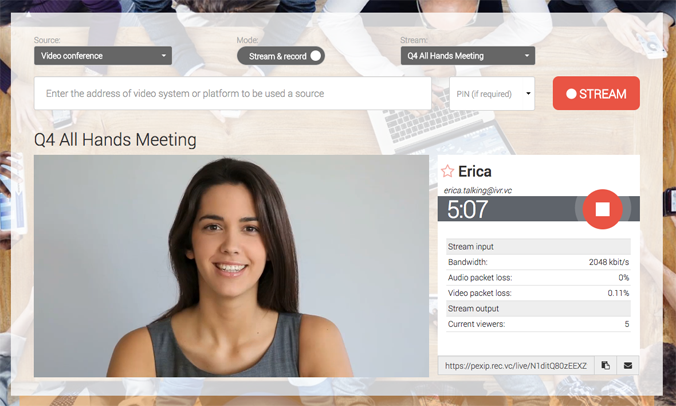
November 17th, 2016 by admin
Today we released a beta version of the new REC.VC user interface on my.rec.vc and on all white label partner sites. The new beta user interface will live alongside the existing user interface for some time and users will be able to switch between the two user interfaces.
Key highlights of the new beta user interface include:
- Improved handling of the Source for recording & streaming activity
- Select between Video conference (SIP/H.323), Connected camera (WebRTC) and SfB
- Easy switching between the Modes: Record-only and Stream & Record
- Enhanced rendering on hand-held devices
We invite any REC.VC user (partner, customer or prospect) to test the beta user interface. New users can register for a free trial account on my.rec.vc.
How to test
Login to your existing REC.VC account on my.rec.vc or on your white label site. From there, click on the graphic similar to the one below, to switch from the existing user interface to the beta user interface.

Give us feedback!
We appreciate any feedback and the new beta user interface includes a Feedback button in the lower right hand corner of the interface, enabling users to submit their feedback.
Posted in New features Tagged with: recording, sfb, streaming, video conference

September 15th, 2016 by admin
Media Network Services (MNS), the leader in cloud-based recording & streaming of video meetings, today announced general availability of REC.VC with support for Skype for Business (SfB) video recording & streaming.
“Today is a great day for Skype for Business users around the world as we have removed the complexity of recording and streaming. They can now record or stream a video meeting or event simply by calling their REC.VC video address from the SfB client on their PC or Microsoft Surface Hub,†said Kjell Oksendal, CMO and SVP Global Alliances. “For organizations with multiplatform collaboration environments including Cisco, Microsoft, Pexip and Polycom, REC.VC is the perfect cross-platform option to simplify video meeting recording & streaming.â€
REC.VC is delivered as a global cloud service with production environments in North America and Europe, and a global network for best input and output quality regardless of source and viewer locations.
REC.VC subscriptions start at USD 99 per month for organization-wide deployment.
Visit www.rec.vc/sfb for further details about REC.VC for Skype for Business and free trial.
Video tutorial on how to record a Skype for Business meeting:
Video tutorial on how to stream a Skype for Business meeting:
Posted in How to, New features, Press release, Video clip Tagged with: recording, skype for business, streaming